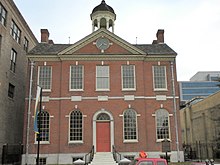Delaware Historical Society
 Logo of the Delaware Historical Society | |
 Location in Delaware | |
| Established | 1864 |
|---|---|
| Location | 504 N. Market Street, Wilmington, Delaware |
| Coordinates | 39°44′34″N 75°33′01″W / 39.742785°N 75.550382°W |
| Type | History |
| Director | David Young, Ph.D. |
| President | Margaret Laird, Ph.D. |
| Public transit access | |
| Website | Official Website |
The Delaware Historical Society began in 1864 as an effort to preserve documents from the Civil War. Since then, it has expanded into a statewide historical institution with several buildings, including Old Town Hall and the Delaware History Museum, in Wilmington and the historic Read House & Gardens in New Castle.
The society participates in joint marketing with the Delaware Tourism Office, the Greater Wilmington Convention & Visitors Bureau, and the Brandywine Museums & Gardens Alliance.[1]
Delaware History Center[]

The Society's Wilmington Campus is located between 5th and 6th Streets on Lower Market Street in Wilmington. This row is the historic shopping district and currently markets itself as the LoMa Design District to promote urban redevelopment. The complex includes an arch over the street.
Delaware History Museum[]
The main museum consists of two permanent exhibit halls in a converted 1941 art deco Woolworth's store, one of two that used to operate on Market Street. Exhibits include “Delaware: One State, Many Stories,” Discover Delaware and the Jane and Littleton Mitchell Center for African American Heritage.
Old Town Hall[]

The Old Town Hall served as the city hall for the Burough and later City of Wilmington. Constructed in 1798 in the federal style, the building also included the jail and library. The Marquis de Lafayette received a reception there and President Andrew Jackson was the guest of honor at a dinner. In 1851, the body of Senator Henry Clay was officially laid in state.
Willingtown Square[]

Willingtown Square is a collection of buildings relocated from other sections of downtown to make way for high rise construction. Started as part of the bicentennial celebration in 1976, the square is named after Thomas Willing, the founder of Wilmington. [2]
The buildings' interiors serve as office and meeting space for the society but patrons can access the courtyard and grounds.

| [3] Building Name | Built | Construction | Original Use | Relocated |
|---|---|---|---|---|
| Cook-Simms House | 1778 | Flemish bond | Herbal medicine shop, Residence | 1976 |
| Catherine Coxe House | 1801 | Band Box | Residence | 1976 |
| Margaret Coxe House | 1801 | Band Box | Residence | 1976 |
| Jacobs House (aka Zachariah Ferris House) | 1748 | Flemish bond | Residence | 1976 |
| Jacob Dingee House | 1771 | Flemish bond | Cabinet workshop, Residence | 1976 |
| Obidiah Dingee House | 1773 | Flemish bond | Cabinet workshop, Residence | 1976 |
Library and research center[]

The society provides free access to a research library with unique special collections. The collection includes work on Delaware genealogy, maps, and underground railroad as well as a letter from George Washington to Caesar Rodney.[4] Senator William V. Roth's widow donated all of his papers to the library.[5] The library is open Mondays from 1pm to 9pm, Tuesdays and Thursdays from 9am to 1pm, Fridays from 9am to 5pm, and the third Saturday of every month from 10am to 4pm.
Located at 505 North Market Street, a former Artisans Savings Bank branch location houses the library. Tilghman Ware Company built the art deco structure in 1930–31.[6]
Read House and gardens[]
Located in New Castle on the Strand, the George Read II House was built in 1801 by George Read, Jr., the son of George Read, a signer of the Declaration of Independence. The house was the largest in the state at the time it was built with 22 rooms covering 14,000 square feet (1,300 m2).[7] The house also includes a rathskeller in the basement that served as a speakeasy. This dates from the 1920s when the Laird family owned the house and were bootleggers. The house was restored in 1986.[8]
See also[]
- Hagley Museum and Library
- History of Delaware
- Stonum
- List of museums in Delaware
- National Register of Historic Places listings in Wilmington, Delaware
- Delaware Art Museum
References[]
- ^ "2 museums drop entrance fee". The News Journal. 2008-12-25. Retrieved 2009-02-01.[dead link]
- ^ Pfingsten, William (2008-08-31). "Willington Square". The Historical Marker Database. Retrieved 2009-03-01. Cite journal requires
|journal=(help) - ^ "Willington Square". Historical Society of Delaware. Archived from the original on 2008-05-11. Retrieved 2009-03-01. Cite journal requires
|journal=(help) - ^ "Research Library". Delaware Historical Society. Archived from the original on 2009-04-05. Retrieved 2009-03-02. Cite journal requires
|journal=(help) - ^ "Harrison Wick '00". Washington College. Retrieved 2009-03-02. Cite journal requires
|journal=(help)[permanent dead link] - ^ "Historic Building Notes on Selected Market Street Properties" (PDF). East Coast Greenway. 2008-05-08. Archived from the original (PDF) on 2008-07-05. Retrieved 2009-03-10. Cite journal requires
|journal=(help) - ^ "Read House & Gardens". Historical Society of Delaware. Archived from the original on 2008-05-11. Retrieved 2009-03-02. Cite journal requires
|journal=(help) - ^ "New Castle Attractions". The New York Times. Retrieved 2009-03-02.
External links[]
- State historical societies of the United States
- Museums established in 1864
- Brandywine Museums & Gardens Alliance
- Historic house museums in Delaware
- New Castle, Delaware
- Buildings and structures on the National Register of Historic Places in Delaware
- Historic districts in Delaware
- Buildings and structures in Wilmington, Delaware
- F. W. Woolworth Company buildings and structures
- Museums in Wilmington, Delaware
- History museums in Delaware
- Libraries in Delaware
- Historical societies in Delaware
- Clock towers in the United States
- National Register of Historic Places in Wilmington, Delaware
- 1864 establishments in Delaware


